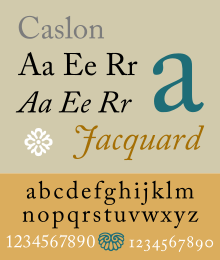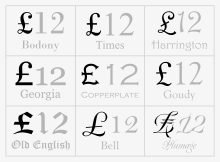Pound sign
| £ | |
|---|---|
Pound sign | |
| In Unicode | U+00A3 £ POUND SIGN (HTML £ · £) |
| Currency | |
| Currency | Pound sterling |
| Different from | |
| Different from | U+20A4 ₤ LIRA SIGN U+0023 # NUMBER SIGN |
The pound sign £ is the symbol for the pound sterling – the currency of the United Kingdom and previously of Great Britain and of the Kingdom of England. The same symbol is used for other currencies called pound, such as the Gibraltar, Egyptian, Manx and Syrian pounds. The sign may be drawn with one or two bars (this is a font design choice) but the Bank of England has used the one-bar style exclusively since 1975.
In Canada and the United States, "pound sign" refers to the symbol # (number sign).
Origin[]
The symbol derives from the upper case Latin letter L, representing libra pondo, the basic unit of weight in the Roman Empire, which in turn is derived from the Latin word, libra, meaning scales or a balance. The pound became an English unit of weight and in England became defined as the tower pound (equivalent to 350 grams) of sterling silver.[1][2] According to the Royal Mint Museum:
It is not known for certain when the horizontal line or lines, which indicate an abbreviation, first came to be drawn through the L. However, there is in the Bank of England Museum a cheque dated 7 January 1661 with a clearly discernible £ sign. By the time the Bank was founded in 1694 the £ sign was in common use.[3]
However, the simple letter L, in lower- or uppercase, was used to represent the pound sterling in printed books and newspapers until well into the 19th century.[4] In the blackletter type used until the seventeenth century,[5] the letter L is rendered as .
Usage[]
The pound sign is placed before the number (e.g., £12,000) and separated from the following digits by no space or only a thin space.
Other English variants[]
Canadian English[]
In Canadian English the symbols £ and # are both called the pound sign, but the # is also known as the 'number sign' and as the 'noughts-and-crosses board'.[a][6]
US English[]
In American English, the term "pound sign" usually refers to the symbol # (number sign), and the corresponding telephone key is called the "pound key".[7]
Historic variants[]
Double bar style[]
Banknotes issued by the Bank of England since 1975 have only used the single bar style as a pound sign.[8][9] The Bank used both the two-bar style (₤) and the one-bar style (£) (and sometimes a figure without any symbol whatever) more or less equally since 1725 until 1971, intermittently and sometimes concurrently.[8] In typography, the symbols are allographs – style choices – when used to represent the pound; consequently fonts use U+00A3 £ POUND SIGN (Unicode) code point irrespective of which style chosen, (not U+20A4 ₤ LIRA SIGN despite its similarity). It is a font design choice on how to draw the symbol at U+00A4: although most computer fonts do so with one bar, the two-bar style is not rare (as may be seen in the illustration above).
Other[]

In the eighteenth-century Caslon metal fonts, the pound sign was identical to an italic uppercase J, rotated 180 degrees.[10]
Currencies that use the pound sign[]
- Egypt: Egyptian pound
- Falkland Islands: Falkland Islands pound
- Gibraltar: Gibraltar pound
- Guernsey: Guernsey pound
- Isle of Man: Manx pound
- Jersey: Jersey pound
- St Helena: Saint Helena pound
- South Sudan: South Sudanese pound
- Sudan: Sudanese pound
- Syria: Syrian pound
- United Kingdom: Pound sterling
Former currencies[]
- Australia: Australian pound
- Canada: Canadian pound
- Cyprus: Cypriot pound
- Ireland: Irish pound
- New Zealand: New Zealand pound
Code points[]
In the Unicode standard, the symbol £ is called POUND SIGN, and the symbol ₤ is the LIRA SIGN. These have respective code points:
- U+00A3 £ POUND SIGN (HTML
£·£· inherited from Latin-1)[11] - U+20A4 ₤ LIRA SIGN (HTML
₤)[12]
Unicode notes that the "lira sign" is not widely used and was added due to both it and the pound sign being available on HP printers.[13]
The encoding of the £ symbol in position xA3 (15610) was first standardised by ISO Latin-1 (an "extended ASCII") in 1985. Position xA3 was used by the Digital Equipment Corporation VT220 terminal, Mac OS Roman, the Amstrad CPC, the Commodore Amiga and the Acorn Archimedes.
Many early computers (limited to a 7-bit, 128-position character set) used a variant of ASCII with one of the less-frequently used characters replaced by the £. The UK national variant of ISO 646 was standardised as BS 4730 in 1985. This code was identical to ASCII except for two characters: x23 encoded £ instead of #, while x7E encoded ‾ instead of ~. MSDOS on the IBM PC originally used a non-standard 8-bit character set Code page 437 in which the £ symbol was encoded as x9C; adoption of ISO character codes only came later with Microsoft Windows. The Atari ST also used position x9C. The HP LaserJet used position xBA for the £ symbol, while most other printers used x9C. The BBC Ceefax system which dated from 1976 encoded the £ as x23. The ZX Spectrum and the BBC Micro used x60 ` (grave). The Commodore 64 used x5C \ while the Oric used x5F _. IBM's EBCDIC code page 037 uses xB1 for the £ while its code page 285 uses x5B. ICL's 1900-series mainframes used a six-bit (64-position character set) encoding for characters, loosely based on BS 4730, with the £ symbol represented as octal 23 (hex 13, dec 19).
Entry methods[]
This section needs additional citations for verification. (November 2019) |
Typewriters[]
Typewriters produced for the British market included a "£" sign from the earliest days, though its position varied widely. A 1921 advertisement for an Imperial Typewriters model D, for example[14] shows a machine with two modifier shifts (CAPS and FIG), with the "£" sign occupying the FIG shift position on the key for letter "B". But the advertisement notes that "We make special keyboards containing symbols, fractions, signs, etc., for the peculiar needs of Engineers, Builders, Architects, Chemists, Scientists, etc., or any staple trade."
On Latin-alphabet typewriters lacking a "£" symbol type element, a reasonable approximation could be made by overtyping an "f" over an "L".
Compose key[]
The compose key sequence is:[15]
- Compose+L+-
Windows, Linux, Unix[]
On Microsoft Windows, Linux and Unix, the UK keyboard layout has the "£" symbol on the 3 number key and is typed using:
- ⇧ Shift+3
On a US-International keyboard in Windows,[16] the "£" can be entered using:
- ⇧ Shift+AltGr+4
- ⇧ Shift+Ctrl+Alt+4 (on older keyboards without an AltGr key)
On a US-International keyboard in Linux and Unix, the "£" can be entered using:
- Ctrl+⇧ Shift+U followed by a 3
- ⇧ Shift+AltGr+3
In Windows, it can also be generated through the Alt keycodes, although the results vary depending on factors such as the locale, codepage and OS version:
- Alt+0163 (keeping Alt pressed until all 4 digits have been typed on the numeric keypad only)
- Alt+156 (this also works in MS-DOS)
The Character Map utility and Microsoft Word's Insert Symbol commands may also be used to enter this character.[b]
Mac OS[]
The symbol "£" is in the MacRoman character set and can be generated on most non-UK Mac OS keyboard layouts which do not have a dedicated key for it, typically through:
- ⌥ Option+3
On UK Apple Mac keyboards, this is reversed, with the "£" symbol on the number 3 key, typed using:
- ⇧ Shift+3 (and the number sign "#" generated by ⌥ Option+3)
Android[]
Pressing and holding the local currency sign will invoke a pop-up box presenting an array of currency signs, from which the pound sign may be chosen.[17]
Other uses[]
The logo of the UK Independence Party, a British political party, is based on the pound sign,[18] symbolising the party's opposition to adoption of the euro and to the European Union generally.
A symbol that appears to be a double-barred pound sign is used as the logo of the record label Parlophone. In fact this is a stylised version of a blackletter L (), standing for Lindström (the firm's founder Carl Lindström).
The pound sign was used as an uppercase letter (the lowercase being ſ) signifying [ʒ] in the early 1993–1995 version of the Turkmen Latin alphabet.[19]

